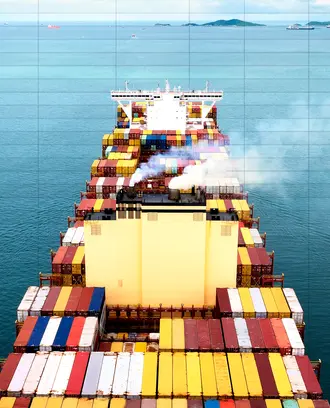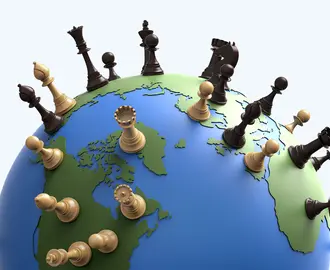Credit: Laura Wentzel
When we think about major figures in global technology, we often focus on inventors like Thomas Edison, with the light bulb, or Tim Berners-Lee, with the World Wide Web. Alternatively, we may look to builders of organizations that develop and spread innovations, such as Thomas Watson with IBM or Bill Gates with Microsoft. But other little-known figures have also played a critical role in the spread of technologies: engineers who set national and, especially, global standards.
JoAnne Yates is a professor of managerial communication and work and organization studies at MIT Sloan. Her co-author, Craig N. Murphy, is a professor of political science at Wellesley College.
Standards surround us in our daily lives, enabling most of what we do. Standards provide compatible interconnection of devices (e.g., standard screw threads and ASCII characters) and platforms on which innovation can occur (e.g., standard steel beams and internet protocols). Intermodal shipping containers, standardized first in the United States and then internationally in the 1960s, allowed items to be packed into containers once, then to travel by ship, railroad, or truck to their destinations, drastically reducing their transportation costs and opening up global markets for goods. When we screw a new garden hose to an outdoor faucet or use our smart phones to exchange messages, we are depending on standards to enable these everyday activities.Despite their many benefits, we rarely acknowledge the utility of standards, though we may lament their absence, as when we have to carry converters for international travel because of the lack of international electrical plug and outlet standards. Moreover, we know almost nothing about how and by whom standards were created.
Our recent book, “Engineering Rules: Global Standard Setting since 1880” focuses on voluntary standards — that is, standards that governments do not mandate manufacturing and user firms to use, but that firms voluntarily adopt. They are willing to adopt them because engineers representing them are members of the technical committees that develop the standards through a painstaking consensus process. In the late 19th and early 20th century, engineers seeking to contribute to the common good developed this process and began setting the many voluntary standards on which we depend today.
We would like to acknowledge the many unsung heroes of voluntary standardization. We will focus on three figures who served as what we call standardization entrepreneurs in each of three waves of standardization: Charles le Maistre in the first wave (from the turn of the 20th century to the 1950s), Olle Sturén in the second wave (from after the Second World War to the late 1980s), and Tim Berners-Lee — not as inventor of the web but as founder of a key standard-setting body — in the third wave (from the late 1980s to the present). All three, you may have noticed, are men (and, indeed, white men). The community of engineers involved in standardization was, as far as we can tell, entirely male in the first wave and overwhelmingly male during the second. Only in the third wave do women begin to play a role in standardization, and that role is still not as large as we might wish for it to be.
Charles le Maistre, evangelist for national and international standardization
Born in 1874, the electrical engineer Charles le Maistre played a key role in the first wave of national and international standard-setting. He was a secretary of the first national voluntary standardization body, founded in Britain in 1901. In that capacity, he spread throughout the British Empire the ideals of balanced, consensus-based standard-setting as an economic and social boon. He believed that engineers in all industrializing countries should form such bodies and actively encouraged and aided many, including those in the United States, France, the Soviet Union, and Sweden, in establishing their own such bodies during and after the First World War.
At the same time that he encouraged the formation of national standard-setting bodies, he was also promoting and laying the groundwork for international standardization. When the first still-surviving international standardization body in the domain of electrical engineering, the International Electrotechnical Commission, or IEC, was ratified in 1908, he was named its general secretary. In its early years, for example, he worked with IEC presidents, supporting standardization that would enable the electrical grids of Europe and North America and the global markets for electrical generators and equipment. He encouraged electrical engineers in nations around the world to form electrical engineering societies and send delegations to IEC. He saw this mode of voluntary international standard-setting as promoting world peace as well as an international electrical industry and markets.
During the 1920s le Maistre convened meetings of the secretaries of the national bodies in Europe, the Americas, and beyond. The secretaries began by reinforcing the principles of voluntary, non-governmental standard-setting at the national level; soon they began to consider forming a broad-based international body that standardized a large range of industrial products. Because of various political struggles (e.g., between metric and non-metric countries), le Maistre ultimately did not take a leading role in the short-lived international body created then. After the Second World War, however, at the start of the second wave of standardization, he again played a major diplomatic role as standardizers from the war victors formed a new body, the International Organization for Standardization, known as the ISO. In keeping with their belief that standardization should transcend politics and that all stakeholders should be at the table, he spent the final few years before his death working to bring former enemy countries such as Germany and Japan into ISO and to keep the Soviet Union in it in spite of growing Cold War tensions.
He was remembered by colleagues in a jumble of metaphors as “the father of international standardization,” as “married to standardization,” and as a “deus ex machina.” Although well known to standardizers during his life, he was never a broader public figure and is long forgotten now. Yet he was instrumental in spreading the gospel of voluntary standardization and supporting the organizations that created our industrial infrastructure during the first half of the 20th century.
Olle Sturén and the internationalization of standard-setting
The second wave of standardization began with the formation of ISO, but that body got off to a slow start. The key figure who jump-started international standard-setting was a Swedish engineer named Olle Sturén. Beginning in 1968, this longest-serving general secretary of ISO was committed to increasing the pace and international scope of ISO’s activities. He brought many new and newly industrializing countries of the post-war era, from Ghana to the People’s Republic of China, into ISO, after first developing their national standardization capabilities and organizations. He travelled twice to China, with the second trip in 1978 following Deng Xiaoping’s rise to power and China’s admission to ISO.
Sturén also prioritized areas he saw as critical for standardization and established technical committees to work on them. One of these areas was intermodal shipping containers. In setting international standards for the big metal boxes, ISO made possible the transformation of world trade. Containers reduced prices and globalized markets for consumer and producer goods, making possible today’s global supply chains. Some economists have argued that the cost savings generated by container standardization spurred the massive increase in global trade more than any of the tariff reductions under the General Agreement for Tariffs and Trade or its successor, the World Trade Organization. Sturén’s other early priorities included standards for connecting computers and for dealing with air pollution, key standards for the 21st century.
Through his technical priorities as well as his expansion of the scope of international standardization, Sturén promoted global technological and economic integration.
Tim Berners-Lee as standardization entrepreneur
Among the computer-savvy public, Tim Berners-Lee is widely recognized for his invention of the World Wide Web while he was a software engineer at CERN (the European Organization for Nuclear Research) in Geneva. Much less well known is his important activity as a standardization entrepreneur. After inventing universal resource identifiers (URLs), hypertext markup language (HTML), and hypertext transfer protocol (HTTP) in the late 1980s and early 1990s, he decided not to monetize the web himself, instead convincing CERN to let him release his code to the world at no cost. He did not stop there, however. Worried that what became known as the web would become balkanized and not fulfill its promise, he moved to the United States and, with MIT as his academic base, in 1994 created the nonprofit World Wide Web Consortium (W3C) as a standardization body for his creation. This body became one of the new voluntary standards organizations established in the third wave of standardization.
W3C is, in name, a consortium: Its member firms and organizations pay fees to belong and participate in setting standards for the web. The corporate computer consortia that became popular in the U.S. starting in the 1980s were typically composed, at least initially, entirely of firms from one set of stakeholders (e.g., the manufacturers of hardware or software), lacking the multi-stakeholder balance of voluntary consensus standards bodies.
Berners-Lee created W3C, however, so it resembled the traditional national and international multi-stakeholder bodies in many ways. Its sliding scale for fees enabled small firms, nonprofits, and firms from poor countries to join at very reduced rates. W3C also recruited not just web browser companies such as Microsoft and Google, but also web user companies like Netflix and Amazon, and educational and nonprofit organizations with more general interests. Although it lacks the rules about stakeholder balance in the national standards bodies and the rules about national representation and balance of ISO, it has publicly endorsed the value of balance. It establishes technical committees and follows a process that in many ways resembles that of the traditional voluntary standards groups. And because members provide its funding, its standards are not only voluntary, but also open and free standards. Berners-Lee retained certain permanent powers for himself in W3C, but has generally exercised those powers in ways compatible with the traditional voluntary consensus standards bodies.
Although the forces towards balkanization are ever-present, W3C has kept the web unified enough across browsers and users to retain its enormous popularity and social and economic importance. We should see Berners-Lee’s contribution to ongoing web standardization as at least as important as his contribution in inventing it.
***
Charles le Maistre, Olle Sturén, and Tim Berners-Lee deserve to be better known among those interested in global technological and economic integration. More people like them are needed in the future. One of the biggest challenges for voluntary standard-setting is expanding the potential pool of standardizers by including women, minorities, and nationalities not well represented. In our book we identified only one female standards entrepreneur — Alice Tepper Marlin, who established new multi-stakeholder standards organizations around social rather than technological standards, focusing on environmental and labor practices. Women are now more frequently seen in voluntary standard-setting bodies, though they aren’t necessarily in key positions in them. Inclusiveness will be a key challenge for voluntary standardization going forward.
Meanwhile, all of us who benefit from the technology and standards around us should be thankful to these unsung heroes of standardization, whose proselytizing, organization-building, and standard-setting work has made the technological and economic integration of our world possible.



